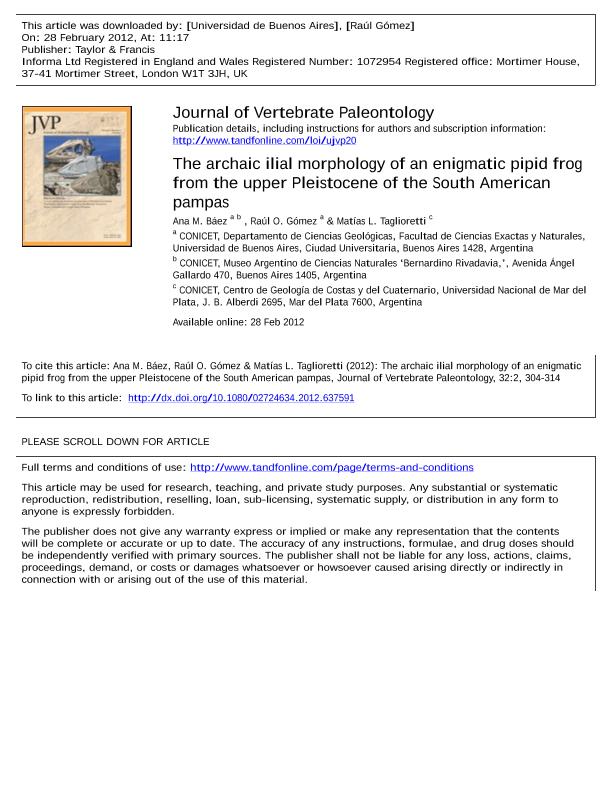Mostrar el registro sencillo del ítem
dc.contributor.author
Baez, Ana Maria

dc.contributor.author
Gomez, Raul Orencio

dc.contributor.author
Taglioretti, Matias Luciano

dc.date.available
2019-01-21T22:30:36Z
dc.date.issued
2012-03
dc.identifier.citation
Baez, Ana Maria; Gomez, Raul Orencio; Taglioretti, Matias Luciano; The archaic ilial morphology of an enigmatic pipid frog from the upper Pleistocene of the South American pampas; Society of Vertebrate Paleontology; Journal of Vertebrate Paleontology; 32; 2; 3-2012; 304-314
dc.identifier.issn
0272-4634
dc.identifier.uri
http://hdl.handle.net/11336/68350
dc.description.abstract
Pipids are odd-looking frogs with a derived morphology that has been considered to be the result of a successful adaptation to a fully aquatic lifestyle. This monophyletic group comprises 33 extant species arranged in three clades mainly distributed in tropical regions of northern South America (Pipa) and sub-Saharan Africa (Xenopodinae and Hymenochirini). Their fossil record, however, documents greater diversity and wider distribution in South America in the Cretaceous and Paleogene. Recently, isolated postcranial bones bearing distinctive pipid features have been collected from Pleistocene beds in Argentina, nearly 2000 km farther south than their present distribution on the continent. Here, we describe a well-preserved pipid ilium possessing features unknown in the living taxa. The fossil is from a new Lujanian (late Pleistocene) locality of the Pampean Region, thereby confirming the intriguing presence of this group in southern South America. We provide a detailed anatomical evaluation of the adult iliac morphology of pipimorphs and use these data, along with molecular data, in a parsimony analysis of living and extinct pipoid taxa to estimate the relationships of the new material. This analysis places the fossil as a stem xenopodine in an unresolved polytomy together with Xenopus romeri from the upper Paleocene-lower Eocene of Brazil and two taxa from the Eocene of Patagonia. These Pleistocene pipid records in the Pampean region and subsequent disappearance may reflect latitudinal shifts owing to the rapid climate changes related to the glacial/interglacial cycles.
dc.format
application/pdf
dc.language.iso
eng
dc.publisher
Society of Vertebrate Paleontology

dc.rights
info:eu-repo/semantics/openAccess
dc.rights.uri
https://creativecommons.org/licenses/by-nc-sa/2.5/ar/
dc.subject
Pipidae
dc.subject
Pleistocene
dc.subject
South America
dc.subject.classification
Paleontología

dc.subject.classification
Ciencias de la Tierra y relacionadas con el Medio Ambiente

dc.subject.classification
CIENCIAS NATURALES Y EXACTAS

dc.title
The archaic ilial morphology of an enigmatic pipid frog from the upper Pleistocene of the South American pampas
dc.type
info:eu-repo/semantics/article
dc.type
info:ar-repo/semantics/artículo
dc.type
info:eu-repo/semantics/publishedVersion
dc.date.updated
2019-01-16T18:28:48Z
dc.journal.volume
32
dc.journal.number
2
dc.journal.pagination
304-314
dc.journal.pais
Estados Unidos

dc.journal.ciudad
Lawrence
dc.description.fil
Fil: Baez, Ana Maria. Universidad de Buenos Aires. Facultad de Ciencias Exactas y Naturales; Argentina. Consejo Nacional de Investigaciones Científicas y Técnicas; Argentina
dc.description.fil
Fil: Gomez, Raul Orencio. Consejo Nacional de Investigaciones Científicas y Técnicas. Oficina de Coordinación Administrativa Parque Centenario. Museo Argentino de Ciencias Naturales “Bernardino Rivadavia”; Argentina
dc.description.fil
Fil: Taglioretti, Matias Luciano. Universidad Nacional de Mar del Plata. Facultad de Ciencias Exactas y Naturales. Instituto de Geología de Costas y del Cuaternario. Provincia de Buenos Aires. Gobernación. Comisión de Investigaciones Científicas. Instituto de Geología de Costas y del Cuaternario; Argentina
dc.journal.title
Journal of Vertebrate Paleontology

dc.relation.alternativeid
info:eu-repo/semantics/altIdentifier/doi/http://dx.doi.org/10.1080/02724634.2012.637591
dc.relation.alternativeid
info:eu-repo/semantics/altIdentifier/url/https://www.tandfonline.com/doi/abs/10.1080/02724634.2012.637591
Archivos asociados
